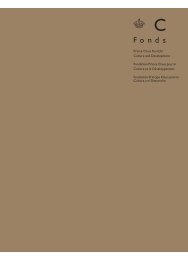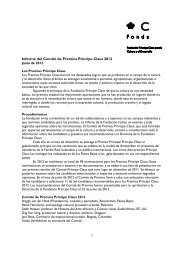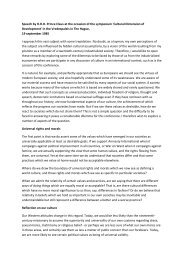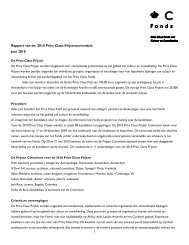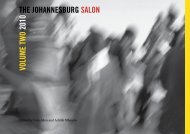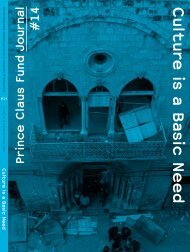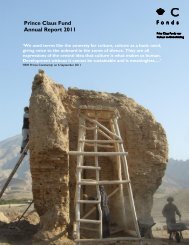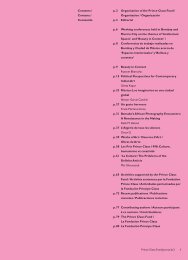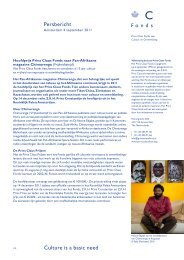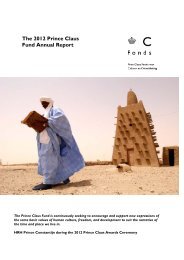3 summer 2011 - Prince Claus Fund
3 summer 2011 - Prince Claus Fund
3 summer 2011 - Prince Claus Fund
- No tags were found...
Create successful ePaper yourself
Turn your PDF publications into a flip-book with our unique Google optimized e-Paper software.
030–053talattekin_alt:turklergaram 29.11.2007 9:22 Uhr Seite 51IX. ta¤l› GROUPSalars and Their LanguageThe Salars are a Turkic people inhabiting the XunhuaSalar Autonomous County in China’s Qinghai Province.According to the 1958 census, there were only 30,000 Salarspeakers. It is now thought that there are more than 40,000.The Salars are thought to have migrated at the end of thefourteenth century from Samarkand and the neighboringregion to the banks of the Huang He River, where they livedside by side with Chinese and Tibetans. As a result, their languageand their Muslim culture had strong Chinese andTibetan influences. The Salars are taught in Chinese schoolsand use Chinese as their official language. This has led to theborrowing of a large number of Chinese and Tibetan words. A.Samoylovich included Salar in the Kipchak-Turkmen group ofTurkic languages, while Turcologists such as Poppe, Menges,Pritsak, K. Thomsen, and Baskakov regard Salar as a dialect ofNew Uighur. According to E. R. Tenishev, Salar belongs to theOghuz group of Turkic languages, but with the admixture ofcertain Kipchak elements. These views are very rightly criticizedby V. Drimba, who regards Salar as an independent dialect orlanguage. In our opinion, Salar forms an independent group ofTurkic languages classified according to tağlığ as a criterion.The word tağlığ appears as tağlı in this language as a result ofthe disappearance of the final /€/. The same word appears astağlıq in New Uighur, tawlı in the Kipchak group, and dağlı inthe Oghuz group. Salar, which has no written form, has twomain dialects: (1) The Gey-tszı dialect (together with theChinshu dialect), (2) the dialect of the Da€l›k Minta region. Theformer is spoken in Xunhua Province and the latter in the East.Most Salars use the Gey-tszı dialect. Both dialects contain featurespeculiar to the Oghuz-Kipchak groups. This is perfectlynatural, as in Kashgarl›, the ethnic term for Salar, is one and thesame as Salgur (Turkmen Salır or Salar), which is recognized asone of the twenty-two Oghuz tribes.Some of the characteristicsof Salar are:1. As noted above, the most important feature of Salaris the disappearance of /€/ and /g/ at the end of multisyllabicwords: Old Turkic a:çığ > a:ci “pain,” OT sa:rığ > sa:rı, sa:ri, sa:re“yellow,” OT uluğ > ullı, ulli, uli “great,” kü:çlüğ > küşli “strong,”OT kiçig > kiçi “small,” etc.2. In Salar, a /d/ in front of /i/ generally changes to /c/:yedi > yici “seven,” aldı > alci, almadı > almaci, ala almadı > alalmaci“couldn’t get,” etc.3. In Salar, one finds that /ç/ becomes /fl/ in severalwords: ağaç > ağaş, üç > uş “three,” kü:çlüg > küşli, kuşli“strong,” etc. This sound change occurs in several Turkic languagesof the Kipchak group.4. Another characteristic feature of Salar is the preservationof the initial /t/, as opposed to normal practice in theOghuz group of Turkic languages: tağ “mountain,” tokos “nine,”temur “iron,” totax “lip,” teşüx, teşux “hole,” töve “camel,” etc.5. Yet another characteristic feature of Salar is thepreservation, as can be seen in the examples given above, of theprimary long vowels in Old Turkic: a:çığ > a:ci “pain,” sa:rığ >sa:rı, sa:ri, o:tun > o:tın “firewood,” bu:tak > pu:tax “branch,” etc.6. The preservation of the pronominal /n/ in Salarshows the absence of any close relationship between Yellowand New Uighur (and Uzbek): taşinda “except,” işinda “in,”ya:nina “near,” ilinda “in front of,” susınten “from its water,” etc.A few sentences in Salar: Anigi apasi takka yirtux vurmavamiş “His father went shooting”; Pu a’tcux yaxşi a’ttır “This is agood horse”; Pu oy minigidur “This house is mine”; Pu zanzusinigi ider-o? “Is this cup yours?” Men sinigi kuyung iter “I amyour husband”; Vular va’por “They are going”; Seler varoxtır “Youaren’t going”; Piser varaloxtır “We can’t go.”X. hadak GROUPThe Khaladj and Their LanguageThe Khaladj are a Turkic people inhabiting a region incentral Iran between the cities of Hamadan and Qom, beginningabout 75 miles southwest of the capital, Tehran. The numberof Khaladj speakers is around 18,000.Until relatively recently, Khaladj was regarded as a dialectof Azeri Turkish. As a result of research and investigations inIran in 1968, however, the German Turcologist Gerhard Doerferproved that Khaladj was a Turkic language preserving a numberof archaic features.1. One of the most important of these archaic featuresin Khaladj, which would appear to be a continuation of the oldArgu dialect, is the systematic preservation of the initial /h-/: ATha:r-, ha:rı- “to be tired” > Khaladj harkan “tired” (MK a:r- “tobe tired,” Uzbek hår-, håri- “to be tired,” New Uighur har-,Uighur, har-, Karakalpak hari-, Turkish argın “tired”), AT hark“dung” > Khal. hark (MK ark), AT hürk- “to be frightened” >Khal. hirk- (AT hürk-, Trk. ürk-), etc.2. The preservation of the /-guluk/-gülük/ suffix in OldTurkic, signifying obligation, is one of the most important archaicfeatures in Khaladj: män käl-gülük’äm “I must come,” Bona:ma yaz-guluk’ar “I must be written a letter,” var-guluk’ar “hemust come,” etc.3. The formation of the locative by the /-ça/-çä/ suffixrather than /-da/-dä/ is one of the most important features ofKhaladj: ho här-çä “that man has,” sanduk-ça “in the chest,”şa:m isti-çä “in the evening,” şa:h İsma:il zama:ni-çä “in thetimes of Shah Ismail,” etc.4. There are also a number of archaic formal featuresin Khaladj. One of these is the dative case in Old Turkic, withthe suffix /-ka/-kä/: ta:k-ka “to the mountain,” bu:zäk-kä “calf,”meydan-ka “to the square,” şa:m-ka “in the evening,” häv-kä “tohome,” etc.5. Another archaic feature in Khaladj is the retention ofthe participle suffix /-gli/-gli/ in Old Turkic in the form /-gıli/-gili:/: sat-gıli “salesman,” sävmä-gili “one who doesn’t love,” viergili“one who gives,” etc.6. Another formal feature of Khaladj is the use, as inOrkhon Turkic, of the suffix /-dan/-dän/ alongside the formationof the ablative, of the / -da/-dä/suffix: älisin-dä “from hishand,” oğli kötin-dä “after his son,” ollar-da bädtär “worse thanthem,” etc.7. Another phonetic characteristic of Khaladj is thechange of /ñ/ to /n/: Azeri Turkish ka:ñak “cream” > Khaladjka:nak, AT koñ “sheep” > Khal. kon, ko:n, AT kö:ñ- “to burn” >Khal. kien-, etc.8. One of the most important features is the systematicpreservation or gemination, as in Turkmen and Yakut, of pri-PRESENT-DAY TURKIC PEOPLES AND THEIR LANGUAGES5161 · <strong>Prince</strong> <strong>Claus</strong> <strong>Fund</strong> Reader #3 · Summer <strong>2011</strong>



